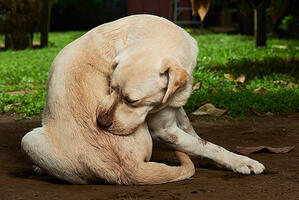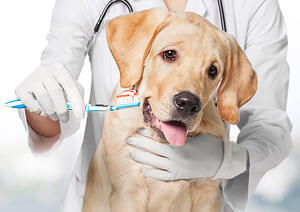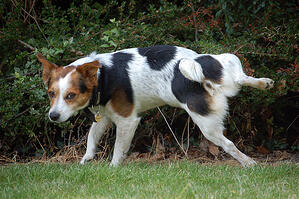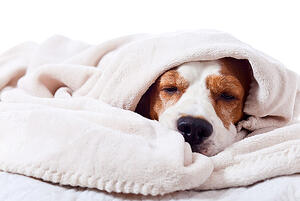When your pup isn’t feeling well, it can be very distressing.
But what can be even more distressing, other than seeing your little guy uncomfortable, is not knowing why it’s happening or when to have it checked out.
Following, we’ll be covering several common dog health problems, including some common causes. Our main focus is going to be how to recognize these illnesses and catch them early.
Just remember, that a lot of general symptoms can have multiple causes and no online article can tell you everything you need to know. If you’re seeing any of these health concerns for your dog, even if they seem minor, consider scheduling with your veterinarian.
Following are 10 health problems commonly seen in dogs, how to recognize that a problem exists, and how to know when to have your vet take a look.
The Big O’s (Overweight, Obese, Overfeeding)
Many folks equate feeding their dog to showing affection, which makes this a tricky topic. The best thing to do is to remain vigilant for signs of early weight gain and discuss how to get back to a healthy weight with your veterinarian if your pooch keeps gaining and you’re at a loss how to stop it.
To catch weight gain early, your pup should maintain a slight “Coke” bottle shape. From the top, there should be a gradual dip inwards from the last rib to the hips. From the side, your dog’s belly should tuck upwards from the last rib towards the groin.
Now, we’ll add in your dog’s ribs as an indicator. You actually should be able to feel your dog’s ribs, at least a little bit. But what’s “okay” and what’s “too much”?
A fun and useful comparison is to use your own fist as a model. Run your hand over your knuckles where they poke out at the top. If your dog’s ribs feel like this, he may be underweight. Now feel along the back of your hand near your wrist. It’s much harder to feel the bones of your hand without pressing hard. For your dog, this would be a concern for her being overweight. Now feel along the top surface of your fingers, just in front of your knuckles. You can feel the bones of your fingers, but they’re not poking out at you. This is exactly what we want a dog’s ribs to feel like.
Check your dog often, especially at times of the year where his activity level might be lower (like during the winter). If you’re unsure where your dog’s weight falls, many vet clinics will let you come in for a weight check and you can see if your pup has gained or lost compared to his previous weight. Your vet can guide you on feeding amounts and weight loss.
Those Irritating Ears: Ear infections
One of the most common ailments I see in dogs is ear infections. Ears can be infected with either bacteria or yeast, a type of fungus. A mix of both organisms is not uncommon.
There are two main reasons for ear infections. The first, which is the easiest to address, happens after a dog gets water down his ear from a bath or after swimming. The excess moisture and warmth leads to microorganism overgrowth.
The second is more complex, which is an underlying skin allergy. Skin allergies in dogs are more like eczema in people, which is an immune-mediated condition. Don’t forget that the skin is a functioning organ just like the heart or kidneys. When the skin encounters allergens, it tries to combat them with inflammatory cells. Unfortunately, this also makes the skin red, broken, and itchy. This change in the skin allows for bacteria and yeast to overgrow, perpetuating the problem.
Ear infections can happen quickly. To stay ahead of them, I recommend cleaning your dog’s ears once weekly with an approved ear cleaner that’s alkalinizing and drying. Squirt some ear solution into his ear, massage at the base of the ear, then wipe out what you can with a cotton ball. Avoid using substances like vinegar, hydrogen peroxide, or rubbing alcohol in your pooch’s ears. Also avoid doing any deep cleaning at home using Q-tips, as there can be a risk to cause damage to the eardrum.
Once weekly cleaning, even if you don’t get much debris out, will at least keep you acquainted with the appearance and smell of your dog’s ears. If you start noticing increased redness/irritation, brown debris developing, and/or a foul odor coming from one or both of her ears, it’s time to see your vet.
The Small, Mighty, and Itchy: Fleas
 Fleas are very small creatures but they pack a really annoying punch. Fleas can be found outdoors on small rodents (though they can’t survive for long off a host) and can thus easily catch a ride on your dog and be brought inside.
Fleas are very small creatures but they pack a really annoying punch. Fleas can be found outdoors on small rodents (though they can’t survive for long off a host) and can thus easily catch a ride on your dog and be brought inside.
Most folks that endure a flea infestation pray it never happens again. It can sometimes take 2 months or more to eliminate an infestation. If your dog sets up with fleas and brings them indoors, they lay eggs under furniture, between floorboards, and in carpet fibers. In a couple of weeks, the eggs pupate and then hatch into adult fleas to continue the cycle.
While most fleas that infest dogs cannot cause infestations on people, they will still bite people causing a lot of irritation and a public health risk. And this doesn’t just happen in warm months. Fleas commonly overwinter in homes and will seek out furry friends to feed on.
If that’s not enough to get your skin crawling, consider this: if a dog ingests a flea, he can acquire a tapeworm, which is the most common method of dogs developing tapeworm infections.
The best way to avoid a flea problem? Prevent them from infesting your pup in the first place! There are many topical and oral flea preventatives out there. Discuss with your vet which would be the most appropriate.
But It Looked So Tasty: Diarrhea and Vomiting
Diarrhea and vomiting can have many causes. The most preventable are caused by dietary indiscretion and intestinal parasites.
As mentioned in last week’s article, keep an eye on your dog’s environment. Make sure that the kitchen counters are clear of human foods. And remember, a dog’s reach is farther than you think. Also find a trash can that has a lockable lid, to keep all of those table scraps inaccessible, even if the can gets knocked over.
We’re all accustomed to scanning our phones when strolling along with our pups outside to keep busy and up to date on things, but keep an extra eye when he’s nosing through the grass looking for a prime place to do his business. Animal remains, other animals’ fecal material, food scraps, and trash can all be found littering the roadside and on our front lawns. It only takes a second for a curious dog to quickly swallow a captivating foreign object.
Parasite eggs aren’t just present in other dogs’ fecal material, but also throughout our soil. According to DVM360, a website for veterinary professionals, about 15% of potting soil contains hookworm or roundworm eggs. The soil outside also contains eggs for whipworms, and cysts for coccidia and giardia. If your dog likes to root through the dirt (and what dog doesn’t?), she’s at risk.
Many heartworm preventatives have secondary coverage against intestinal parasites. Discuss with your veterinarian which ones provide the most comprehensive coverage for your area. Coccidia and giardia, unfortunately, cannot be completely prevented, but if your dog develops diarrhea, it’s always best to see your vet and have a stool sample checked. As with many things, catching vomiting and diarrhea early can lead to a faster and less expensive resolution.
Holy Halitosis: Periodontal Disease
I find that folks are either very concerned about the state of their dog’s teeth, or not concerned enough (kind of like with weight!). Studies have shown that dental disease, similar to people, can contribute to disease in other organ systems. Bacteria that develops and accumulates in the mouth can travel through the bloodstream and set up shop in the cardiovascular system on heart valve leaflets, in the kidneys, and other places.
Brushing is the single best preventative method to employ. While you can start at any time, it’s best to start when your dog is very young and incorporate it with his training.
Brushing Tips!
 To start a brushing routine, make sure to get dog toothpaste. Human toothpaste, which contains fluoride, is not appropriate or safe to use in dogs. Start with putting some of the toothpaste on your finger, and get him used to the flavor and motion. Do this for a few days, then transition into using a brush. There are many brush types, but either a toddler toothbrush, which is small and soft, or a finger brush, which is available at many retailers can work best. The finger brush allows for an easier transition.
To start a brushing routine, make sure to get dog toothpaste. Human toothpaste, which contains fluoride, is not appropriate or safe to use in dogs. Start with putting some of the toothpaste on your finger, and get him used to the flavor and motion. Do this for a few days, then transition into using a brush. There are many brush types, but either a toddler toothbrush, which is small and soft, or a finger brush, which is available at many retailers can work best. The finger brush allows for an easier transition.
When brushing, start at the gumline and brush downwards. Try to reach all the teeth, but focus on the canines and large teeth in the back. While brushing once daily would be truly amazing, it’s not practical for most. Set a goal of twice a week to start and go from there.
Dental treats are the second best tool in the arsenal against periodontal disease. Dental treats that have the Veterinary Oral Health Council seal of approval have shown in trials to reduce plaque and tartar build-up. Look for this seal when shopping for dental treats.
Oral hygiene rinses and water bowl additives can be used but they fall into third place. Because they focus on reducing bacteria load but cannot physically remove plaque and tartar, they are the least effective at preventing dental disease, but are certainly worth incorporating.
Despite a good brushing routine, a dental cleaning under anesthesia may be recommended by your vet based on the amount of calculus and gingivitis present. Your vet will be able to discuss the benefits, risks, and costs associated.
Achy and Creaky Joints: Arthritis
Arthritis in dogs is very common, typically happening when our furry friends get into their senior years. If your pup had an athletic injury earlier in life, or if she has hip dysplasia, these signs can develop earlier.
A common sign of early arthritis is difficulty standing up from a sitting position. You may also notice a limp or reluctance to walk initially, but typically arthritic dogs, like people, can “work” out of it after they get going for a few minutes.
Your vet may be able to determine if your dog has arthritis during an annual wellness exam. It’s important to have arthritis diagnosed, as there are many other conditions that can appear like arthritis, like back pain and neurologic conditions, that would be addressed differently. Also, depending on your dog’s level of discomfort with arthritis, other medications or treatments may be recommended.
While you don’t have to severely scale back your pal’s activity (he still needs to run, play, and be happy!) there shouldn’t be an expectation to continue any high levels of work or competition. Keep an eye out during playtime or jogs if you see signs of slowing down or discomfort. Don’t try to push it.
Joint health supplementation can be very beneficial, even before starting anti-inflammatory or pain medications. The Omega-3 Fatty Acids in Fish Oil are a natural anti-inflammatory and in addition to helping over the long-run with joints, your pup’s skin and coat will look great too!
Glucosamine and chondroitin sulfate assist with arthritis by helping to decrease inflammation and promote healthy cartilage, which lines the joint spaces. Many formulations are made for pets, but keep an eye out for the NASC Quality Seal.
Bumpy, Crusty, Flaky Skin: Skin Infections
If you’ve noticed your dog itching and scratching, there could be a few reasons (check fleas above for one of them). But if you notice red bumps or small pustules on the skin of the abdomen or groin, or if your pup has crusty flaky looking areas of his coat (with or without hair loss), a skin infection is possible.
Diagnosing a skin infection requires a vet appointment because your vet will need to look into ruling out other reasons for this appearance (which can include skin mites and another type of fungus, ringworm). However, recognizing potential signs and getting an appointment scheduled earlier rather than later can help shorten the course of treatment and give your pup relief that much faster.
Why do skin infections occur? Very similar to our discussion on ear infections, underlying inflammation and breaks in the skin barrier allow bacteria and yeast to overgrow, causing itching and irritation, which leads to licking, chewing, scratching, and worsening signs. Addressing the infection is usually only the initial part, as determining what underlying food or environmental allergy is present will help reduce future recurrence.
When Ya Gotta Go…: Urinary Tract Infection
 If you notice one day that your dog, who previously has had normal elimination habits, has a pee accident in the house it can be upsetting for both of you. Your dog knows she did something wrong but couldn’t help it, and you now have pee on your beautiful hardwood floor.
If you notice one day that your dog, who previously has had normal elimination habits, has a pee accident in the house it can be upsetting for both of you. Your dog knows she did something wrong but couldn’t help it, and you now have pee on your beautiful hardwood floor.
Urinary tract infections are a common dog health problem, especially in females. A short, wide diameter urinary tract and close proximity to where fecal material exits sets up for risk. This is especially true of females who squat extremely close to the ground to urinate. And as you can imagine, if your poor girl is just getting over a long bout of diarrhea, the urinary tract may be affected not long after.
Signs of a UTI include increased urgency and frequency of urination, with only small amounts of urine being produced. The urine may have a foul odor and sometimes, folks may notice a slight red tinge to the urine on the floor, indicative of blood from urinary tract inflammation.
If you see a pattern of inappropriate urinary behavior develop, it’s important to have your dog checked out at the vet, who will first check a urine sample for signs of infection and may recommend other testing. As you may have guessed from our other topics, UTIs are common, but there are other conditions that can cause urinary accidents, including bladder stones, incontinence, and behavioral issues, so it’s very important to isolate the cause.
Lumps and Bumps: Skin Growths
I know folks that comb over their dog everyday, checking for fleas, ticks, and even any slight thickened or raised area of skin. And I love this, because a lot of the time, I rely heavily on a pup parent to be able to find these. Ticks can be so small, you’d never find one even if you knew where to look. Skin growths can be the same way.
Now, many skin growths, especially in older dogs, can be glandular growths and other than looking like warts, are usually harmless. Cysts can be similar, in that they break open, and can be disgusting, but are otherwise benign. Fatty tumors, also called lipomas, may grow slowly, but most of the time, do not cause any issues.
But here’s the problem: you can’t tell 100% what these are just by looking at them. That’s why it’s important to catch a new growth early and have your vet evaluate it. One of the first steps we do is to try to get a sample of the cells within the growth using a needle and syringe, to look at under the microscope. This is called a fine needle aspirate. But sometimes, the growth may be so small, that actually removing it and sending it out for identification, is the best plan (and kills two birds with one stone so to speak).
Now, you may feel that a growth the size of a pea is no big deal. And you might be right. But if you notice it growing rapidly over the course of several days or a couple weeks, definitely have your vet weigh in on it. If a growth is identified as one that is concerning and needs to be removed, you’ll be glad you took care of it sooner rather than later, both for your pup’s comfort and recovery, as well as your wallet.
I’m Feeling Wheezy: Coughing
 There’s a theme running through this article in that many “common” generic health problems like itchy skin and diarrhea may have a simple cause, but then again, may not. Coughing is no different.
There’s a theme running through this article in that many “common” generic health problems like itchy skin and diarrhea may have a simple cause, but then again, may not. Coughing is no different.
Dogs are seen frequently for coughing and what we think is causing it can depend a lot on how old the dog is, where she’s been recently, what season it is, and of course, the nature of the cough. Is it coming from the upper airway near the throat? Or is it in the lower airway, down in the chest?
When coughing needs to be evaluated, depends on two scenarios. The first is when your dog has never coughed before and suddenly starts doing so frequently and regularly. The second is if your dog maybe coughs occasionally, but the frequency of it begins increasing. Even if this is slowly over time, it indicates that something is changing that needs to be rechecked.
Infectious and inflammatory conditions may crop up quickly whereas chronic diseases often take longer and develop slowly, but there’s no hard and fast rule. Because the cough you’re noticing at home, or at certain times of day, may not be seen or heard during a vet appointment, take a video with your phone. This can be immensely helpful for your vet to isolate where it’s coming from.
Here’s To Your Pup’s Health
Hopefully, your pup isn’t experiencing any of the above health problems but if so, you’ve found some useful guidelines to follow to catch some of them early, or to decide when it’s appropriate to have a doctor appointment scheduled for your pup.
In our next article, we’ll be discussing foods that are important to avoid feeding to your pooch (and to not leave out on the counter!). There will also be an opportunity to give us some feedback and let us know how you are enjoying our Dog Health Series. Stay tuned next week!





